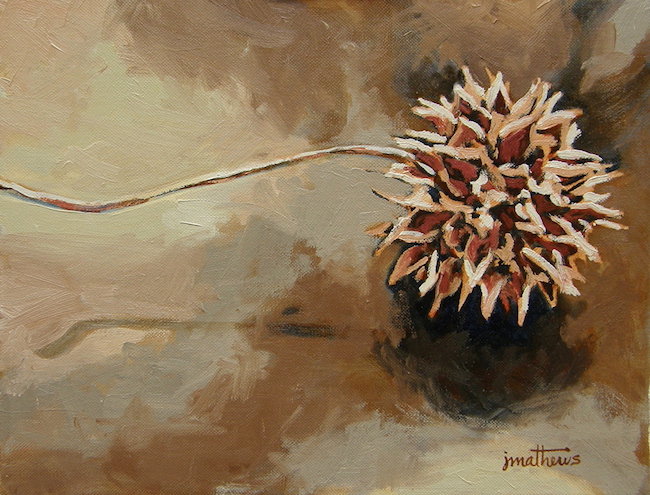Your exhibition is over.
Now what?

The breathing room feels good for a few days, until you realize that you have no thoughts about what to do next.
You were so geared up for this that you haven’t had time to think beyond the preparation and deadlines.
Post-show deflation is real.
But you don’t need to have a show end to experience the business blues. Maybe you’re down because you don’t have a show, you aren’t selling, or people aren’t signing up for your workshop.
Time to explore the next thing.
Without something to work toward, it’s easy to start telling yourself stories. To assess everything that is wrong. Or just to ignore the situation and convince yourself that your inbox needs rearranging.
To feel fulfilled, you need something to look forward to.
Commit to the Big Scary Idea
It’s fine to accomplish small tasks and projects, but it’s the big goals—the things that are a little scary and a lot uncomfortable—that will move your art career further faster.
Big ideas motivate us to take action, and each action builds momentum toward a larger goal. All you have to do is decide to do it and commit to making it happen.

Here are five possibilities to consider for your next project (and a 6th much bigger idea following).
1. Book an exhibition.
If I could choose a single Big Scary Idea for you, it would be to add an exhibition to your calendar. People will be able to see your art in real life, talk with you about it, and tell other people about it.
This exhibition will not be at the same place you’ve been showing for years. There’s nothing big or scary about that.
Look for a venue that is a notch above where you are accustomed to showing.
[ Art Exhibition Checklist and Timeline ]
2. Schedule an open studio.
No “official” studio? Make it a house party.
This open studio should be more prestigious than anything you’ve done before. Perhaps you could:
- Hold back new work to be unveiled.
- Invite another artist and reap the benefits of having two lists.
- Set it up early and invite your VIPS, curators, and interior designers to special showings.
- Give an artist talk.
- Be inspired by Simonne Roy’s successful Quiet Gallery Experience.

3. Have a sale.
Discounting your art is never my first choice, but there are times when it’s necessary.
When you have excess inventory or when your art is moving in a new direction, consider having a sale of earlier work.
As always, discuss arrangements first with your gallerist. And give your collectors and best patrons first choice. This eliminates any sore feelings over higher prices they might have previously paid.
Do it right to encourage more sales. Ten percent off isn’t much of a sale. People are more motivated to buy when it’s at least a 30% discount.
[ How to Have a Sale of Your Art ]
4. Start a blog.
If you write well, take advantage of blogging—especially if you teach.
Blogging, when executed well and consistently, can do the following.
- Position you as the expert.
- Help you to better understand your art.
- Make you more articulate about your work.
- Add more meaningful words to your site that might be found by search engines.
But only if you maintain it.
[ Podcast episode: The Benefits of Blogging About Your Art with Lisa Call ]

5. Teach a new class or workshop.
If you’ve been teaching the same thing in the same way for longer than you can remember, it’s time to rethink and refresh.
Maybe you increase the value by adding more features (and charging more).
Or you offer it in a new location.
Or you find an online platform that’s a good fit.
Or you decide to turn it into a retreat.
When you have a glimmer of an idea for a new class, go for it. You don’t have to know the name of it and you don’t have to know all of the features. You only have to make the commitment.
When you’ve marked all of the above possibilities off your list, there’s one more option. But it’s not for the faint of heart.
Develop a Legacy Project
Legacy projects are much bigger than a Big Scary Idea, and include a combination of these traits:
- They are conceived and created/implemented over the span of multiple years. Perhaps a lifetime.
- They are often wrapped up in a social issue that the artist is passionate about.
- They are rarely forced. The artist is driven by purpose to make it happen—never knowing exactly how it will happen.
- They almost always involve collaborating with other people.
- They might include a fundraising component through crowdfunding, grants, public funds, or a combination of all these.
- They quite often lead to more exposure and opportunities for the artist-organizer.
All of these guests on The Art Biz podcast talked about their legacy projects …
Knit Democracy Together with Eve Jacobs-Carnahan
Building a Legacy Brand and Destination with Sean VanderVliet
The Investing Artist: Art, Real Estate, and Legacy with Mary Erickson
Multi-State Multi-Year Multi-Artist Art Project with Marilyn Artus
Crowdfunding a Public Art Project with Romy Owens

One Final Piece of Advice
When you really want to avoid the blues or predicaments after your project is finished, have another in the pipeline at all times.
This is why you plan. So you don’t have a lull in your business.
[ See Artist Planning Sessions ]
I want to be clear, though, that you need time off. Planning for consecutive projects doesn’t mean you work nonstop.
You must take breaks, vacations, and gather your inspiration and source material in order to be fresh for your next Big Scary Idea.
This article was first published on March 16, 2011. It has been updated and expanded with comments left intact.




More Stories
Donkervoort F22 Is A Lightweight Missile
T-swift dominates the Billboard Hot 100
Links + Before + After Photos of My Brothers Bedroom Makeover!